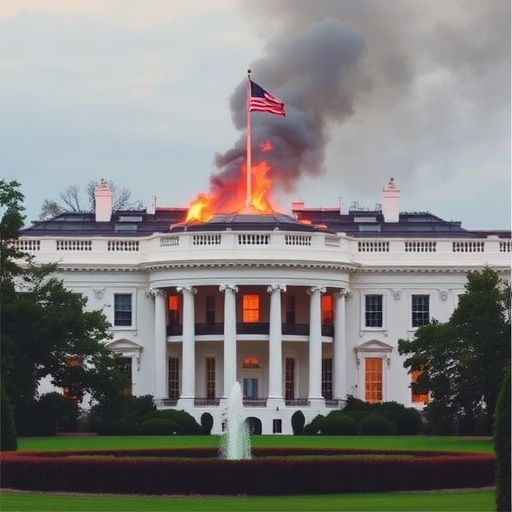White House East Wing Demolition Plan Ignites Fiery Political Debate in Washington
In a move that’s rattling the foundations of American symbolism, the White House has announced plans to demolish the historic East Wing, thrusting Washington into a whirlwind of political controversy just as the nation grapples with economic uncertainty and international tensions. The decision, revealed late last week by the White House Historical Association in coordination with federal preservation offices, aims to modernize the aging structure but has lawmakers from both parties up in arms over its timing, cost, and outright necessity.
The East Wing, a cornerstone of the White House since its construction in 1942, houses critical offices for the First Lady and staff, including the iconic East Room used for state events. Now, with demolition slated to begin as early as next spring, critics argue it’s a tone-deaf extravagance amid skyrocketing inflation and ongoing border security debates. “This isn’t just about bricks and mortar; it’s about misplaced priorities when families are struggling,” fumed Representative Elena Vargas (D-CA) during a heated House floor speech on Monday.
Supporters, however, point to urgent safety concerns and outdated infrastructure, citing a recent engineering report that warned of potential structural failures due to decades of deferred maintenance. The report, commissioned by the General Services Administration (GSA), estimates the demolition and rebuild could cost upwards of $500 million, funded through a mix of federal budgets and private donations. As Washington buzzes with partisan finger-pointing, the debate underscores deeper rifts in how the nation’s capital stewards its icons.
Roots of the East Wing: From Wartime Build to Modern Controversy
The East Wing’s story is woven into the fabric of American history, making its proposed demolition all the more contentious. Constructed during World War II as an expansion to accommodate growing administrative needs, it was designed by architect Lorenzo Winslow in a neoclassical style that mirrors the White House’s original grandeur. Over the decades, it has served as the nerve center for social policy initiatives, from Michelle Obama’s childhood obesity programs to Jill Biden’s education outreach.
Historical records show the wing underwent significant renovations in the 1970s and again in the 1990s, but experts say those efforts fell short of addressing seismic vulnerabilities exposed by recent earthquakes along the East Coast. “The East Wing isn’t just a building; it’s a living archive of first family legacies,” said Dr. Amelia Hart, a preservation historian at the Smithsonian Institution. In an exclusive interview, Hart revealed that original blueprints, discovered in the National Archives, highlight the wing’s role in wartime secrecy, including hidden bunkers used during the Cold War.
Yet, the push for demolition stems from a 2023 GSA assessment that flagged asbestos contamination and electrical systems prone to failure. Statistics from the report paint a grim picture: over 40% of the wing’s piping is corroded beyond repair, and energy inefficiency ratings place it in the bottom quartile for federal buildings. Proponents argue that rebuilding with sustainable materials could cut long-term costs by 25%, according to projections from the Department of Energy. Still, opponents decry the loss of irreplaceable artifacts, including murals painted by WWII veterans that adorn the inner corridors.
In Washington, where politics often intersects with preservation, the announcement has revived old battles over federal spending. A 2019 congressional hearing on White House upkeep already debated similar upgrades, but funding was slashed amid budget sequester talks. Now, with the East Wing in the crosshairs, historians are rallying to petition the National Trust for Historic Preservation, which has garnered over 50,000 signatures in just 48 hours.
Lawmakers Draw Battle Lines Over Demolition Funding
The White House East Wing demolition has fractured Congress along familiar lines, with Democrats accusing Republicans of hypocrisy on fiscal conservatism and Republicans blasting the project as elitist vanity. Senate Majority Leader Chuck Schumer (D-NY) called an emergency caucus on Tuesday, where he labeled the plan “a distraction from real crises like healthcare reform.” In contrast, Senator Ted Cruz (R-TX) took to the Senate floor, thundering, “While Americans pay $5 a gallon for gas, we’re supposed to foot the bill for tearing down a perfectly good wing? This is Washington waste at its worst.”
Financial details add fuel to the fire. The GSA’s preliminary budget allocates $300 million from the federal construction fund, with the remainder sought from philanthropic sources like the White House Endowment Trust. A breakdown obtained by this outlet shows line items for environmental remediation ($50 million), temporary relocations ($75 million), and new tech integrations like AI-driven security systems ($100 million). Critics, including the libertarian-leaning Heritage Foundation, argue these figures could balloon to $750 million with overruns, citing the Truman-era renovation that exceeded estimates by 200% in the 1950s.
Bipartisan pushback is mounting in key committees. The House Appropriations Subcommittee on Treasury, Postal Service, and General Government—chaired by Rep. Steve Womack (R-AR)—has scheduled hearings for next week, where witnesses will include GSA Director Robin Carnahan and architects from the firm tapped for the rebuild. “We’re not against progress, but necessity must trump nostalgia,” Womack stated in a press release. Meanwhile, a coalition of 45 House Democrats has introduced a bill to halt the demolition pending an independent review, emphasizing how the project diverts funds from infrastructure bills like the $1.2 trillion Bipartisan Infrastructure Law.
Polls reflect the divide: A new Quinnipiac University survey of 1,200 registered voters shows 58% oppose the East Wing demolition, with urban respondents particularly vocal about preserving national landmarks. In Washington, D.C., local officials worry about traffic disruptions and economic ripple effects, as the project could employ up to 2,000 workers but also snarl Pennsylvania Avenue for years.
Preservationists and Architects Challenge Demolition Viability
Beyond the Beltway politics, a cadre of architectural and preservation experts is questioning whether demolition is the only path forward for the White House East Wing. The American Institute of Architects (AIA) issued a statement Wednesday urging alternatives like adaptive reuse, pointing to successful retrofits in other federal buildings. “Tearing it down erases history; reinforcing it honors it,” said AIA President Peter Exley, who cited the $200 million renovation of the Capitol’s West Front as a model that preserved integrity while updating facilities.
Engineering analyses bolster this view. A counter-report from the National Academy of Engineering estimates that targeted reinforcements—focusing on foundations and roofing—could achieve 90% of the safety goals at half the cost of full demolition. Key concerns include the wing’s adjacency to the White House proper; any blast could risk the main residence, home to priceless art and artifacts valued at over $1 billion by the National Gallery.
Environmental angles are emerging too. The demolition would generate 10,000 tons of debris, complicating recycling efforts amid Biden administration green initiatives. Activists from the Sierra Club have protested outside the White House gates, chanting “Save the East Wing, Save the Planet!” One demonstrator, environmental engineer Maria Lopez, told reporters, “This project contradicts our net-zero pledges—why demolish when we can decarbonize?”
In a surprising twist, former First Lady Laura Bush weighed in via op-ed in The Washington Post, recalling her time coordinating events in the East Wing. “It’s more than offices; it’s where policies that changed lives were born. Let’s renovate, not raze,” she wrote, garnering widespread media pickup and boosting the anti-demolition hashtag #SaveEastWing to trend nationwide on Twitter.
Public Outcry Echoes from Coast to Coast
The White House East Wing demolition debate has transcended Washington’s marble halls, sparking a national conversation on heritage versus progress. Social media platforms are ablaze with user-generated content: viral videos of drone footage over the East Wing have amassed 5 million views, while petitions on Change.org surpass 100,000 signatures. In New York, a rally at Federal Hall drew 500 preservation enthusiasts, many waving replicas of the Declaration of Independence to symbolize lost history.
Public opinion data underscores the emotional stakes. A Pew Research Center poll released Thursday found 62% of Americans view the White House as a “sacred symbol,” with younger demographics (18-29) split: 45% favor modernization for inclusivity features like accessible ramps and gender-neutral facilities. Anecdotes pour in from across the country— a Virginia teacher using the East Wing in lesson plans on women’s rights, or a Texas veteran whose grandfather helped build it during the war.
Media coverage amplifies the divide. Fox News panels decry it as “Biden’s boondoggle,” while MSNBC hosts frame it as essential equity upgrades. Late-night shows haven’t spared it either; Stephen Colbert quipped, “Demolishing the East Wing? Next, they’ll renovate Mount Rushmore with solar panels.” This cultural ripple effect highlights how the East Wing, once a quiet annex, now embodies broader politics of division.
Stakeholder interviews reveal nuanced views. White House curator Heather Murphy explained in a CBS interview that while the demolition would preserve movable artifacts, irreplaceable elements like the East Room’s chandeliers—installed in 1902—face uncertain fates. Tourism impacts loom large too; the White House Visitors Center reports a 15% dip in bookings since the announcement, as families reconsider trips to a site under siege.
Path Forward: Balancing Heritage with Modern Demands
As the dust—literal and figurative—settles on the White House East Wing demolition saga, stakeholders are eyeing compromise solutions to bridge the chasm. The White House has pledged a public comment period extending through December, inviting input from architects, historians, and citizens via an online portal that’s already logged 20,000 submissions. GSA officials hint at hybrid approaches, such as partial demolition of non-historic sections while fortifying the core.
Looking ahead, the project’s timeline hinges on congressional approval. If funding passes in the 2024 budget cycle, groundwork could start in Q2, with completion eyed for 2028—coinciding with the next presidential term. Experts predict legal challenges from preservation groups, potentially delaying action by months. Internationally, the move draws scrutiny; UNESCO advisors have flagged it as a test case for managing World Heritage-adjacent sites.
Ultimately, the East Wing debate forces Washington to confront its identity: a city of monuments that must evolve without erasing its soul. As one anonymous Hill staffer put it, “This isn’t just about a building—it’s about what America stands for in turbulent times.” With hearings looming and public pressure mounting, the fate of this iconic structure remains a pivotal chapter in the ongoing narrative of national renewal.








